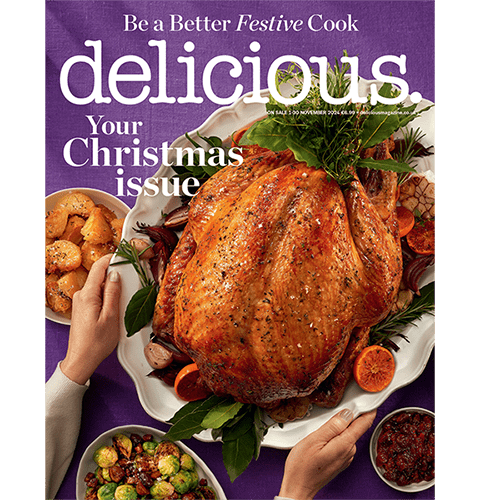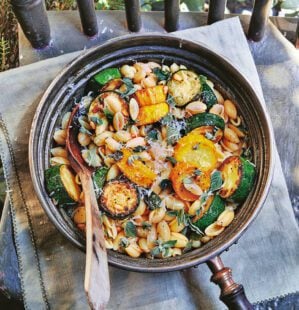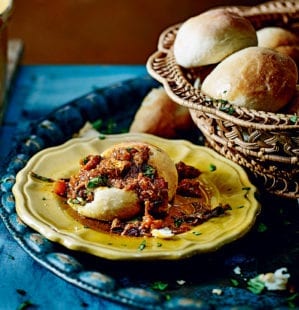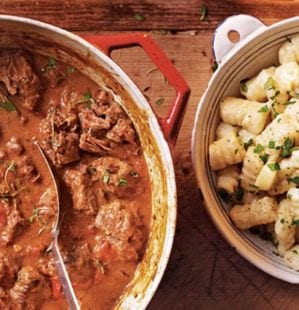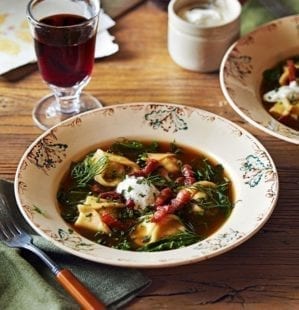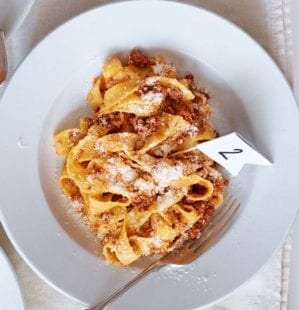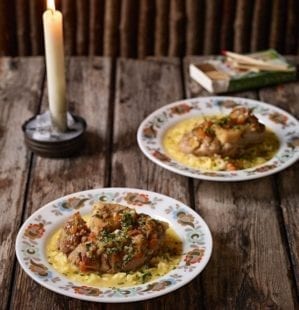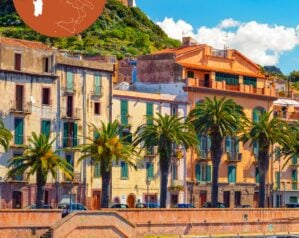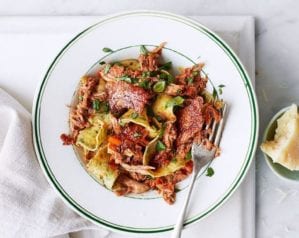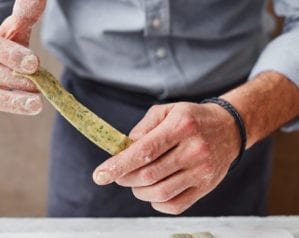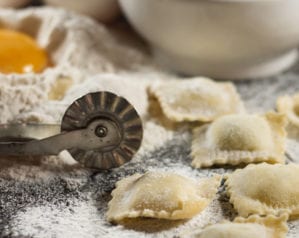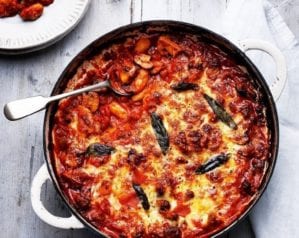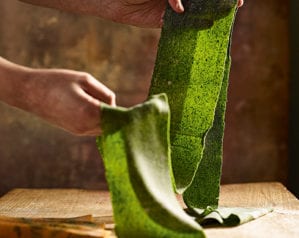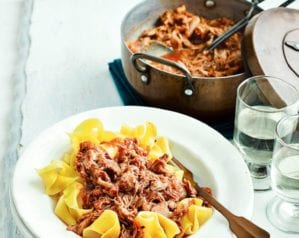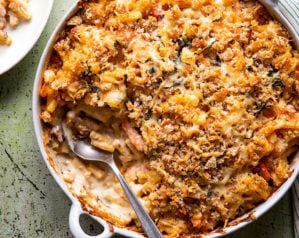
Malloreddus with veal ragù
- Published: 29 Aug 24
- Updated: 17 Sep 24
Chef Antonio ‘Lello’ Favuzzi shares a classic recipe from his beloved Sardinia. The island of Sardinia is a culinary haven, but one of the must-eats if you’re ever there is a bowl of malloreddus – little dumpling-shaped pasta – in a rich ragù. Often flavoured with saffron, they’re a great pasta to make at home as they’re made with nothing more than semolina and water, and you don’t need a pasta machine – just a gnocchi board (which is inexpensive) to help create the ridges. No time to make pasta? See the tip below.
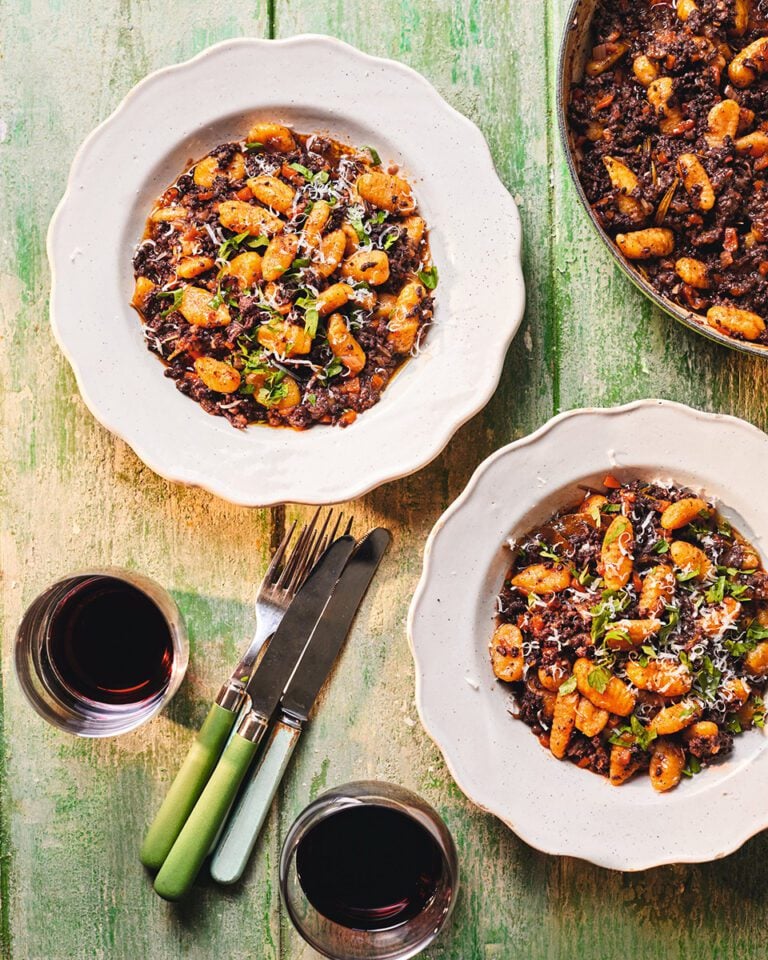
In Sardinia, malloreddus is traditionally shaped by rolling it along the base of a straw basket called a su ciuliri. Sardinian ragùs are often made with wild boar mince, but this recipe is just as delicious with veal or beef mince.
“This rustic recipe holds a special place in my heart,” says Lello. “As a young child growing up in Sardinia, we’d often visit a farmhouse ‘agriturismo’ where we would always prepare and enjoy this typical pasta dish.” Lello grew up in Sardinia and became a chef at a top hotel on the island before moving to London. He’s worked at acclaimed Italian restaurants L’Anima and Mortimer House Kitchen, and is now executive chef at The Belvedere, Holland Park.
Browse our full guide to Sardinian food, from its traditional dishes to the star produce.
-
Serves 6
-
Hands-on time 1 hour. Simmering time 4-5 hours
Before you start
Not up for making the pasta? You can buy malloreddus (sometimes sold as gnocchetti sardi) fresh or dried, although it’s usually not flavoured with saffron. 500g dried or 700g fresh will serve 6 people.
Ingredients
For the malloreddus
- 250ml lukewarm water
- Large pinch saffron strands
- 500g fine semolina, plus extra to dust
For the sauce
- 50ml extra-virgin olive oil
- 1kg veal, beef or wild boar mince
- 1 large onion, finely chopped
- 3 celery sticks, finely chopped
- 2 carrots, finely chopped
- 2 garlic cloves, finely chopped
- 3 rosemary sprigs
- 4 thyme sprigs
- 2 bay leaves
- ½ tsp juniper berries, roughly crushed
- 1.5 litres (2 bottles) red wine
- 400g tin chopped tomatoes
- Finely grated grana padano and/or pecorino (ideally Sardinian) to serve
- Finely chopped parsley to serve
Specialist kit
- Gnocchi board
Method
- Mix 200ml of the water and the saffron in a mixing bowl. Add the semolina, then start working into a dough. Add splashes of the remaining 50ml water until a dough forms (you may not need all the water). Tip the dough out onto a work surface, then knead for 5 minutes until smooth. Cover and leave to rest at room temperature for 2 hours.
- Meanwhile, make the sauce. Pour most of the olive oil into a large saucepan over a medium heat. Add the mince and cook, stirring and breaking it up with a wooden spoon, until deeply browned all over. Remove with a slotted spoon and set aside.
- In the same pan, add the remaining olive oil, then tip in the onion, celery, carrots, garlic, rosemary, thyme, bay and juniper with a pinch of salt. Cook, stirring, for 8 minutes or until the vegetables are soft. Tip the meat back in, stir to combine, then pour in the red wine. Bring to a simmer, cook for 2 minutes to evaporate the alcohol, then add the tomatoes. Bring to a gentle simmer and leave to cook uncovered for 4-5 hours.
- While the sauce simmers, cut off a piece of pasta dough and roll it out into a thin cylinder (about 1cm in diameter). Cut the cylinder into 1cm pieces. Using a gnocchi board (or a su ciuliri for the full Sardinian effect!), push a piece into the ridges with your thumb and drag it down so it curls in on itself. They should resemble fat little bulls. Keep the rolled malloreddus on a tray dusted with semolina. Repeat until all the dough is used up.
- When the sauce is nearly finished, bring a large pan of salted water to the boil. Tip in the malloreddus and cook for 2-3 minutes (or, if using ready-made, according to the packet instructions). Use a slotted spoon to lift the dumplings out of the water and into the sauce. Cook the pasta and sauce together for 2-3 minutes, then season to taste with salt and pepper and divide among bowls. Finish with the grated cheeses and parsley.
- Recipe from September 2024 Issue
Nutrition
- Calories
- 968kcals
- Fat
- 37g (13g saturated)
- Protein
- 46g
- Carbohydrates
- 63g (8.9g sugars)
- Fibre
- 7.3g
- Salt
- 0.7g
delicious. tips
You can make the ragù up to 3 days in advance and keep it in the fridge, ready to reheat when the malloreddus is ready. You can also shape the pasta and keep it on a (covered) semolina-dusted tray in the fridge overnight.
Buy ingredients online
Rate & review
Rate
Reviews
Subscribe to our magazine
Food stories, skills and tested recipes, straight to your door... Enjoy 5 issues for just £5 with our special introductory offer.
Subscribe
Unleash your inner chef
Looking for inspiration? Receive the latest recipes with our newsletter
